American Inquiry and Titanic Investigation - 1912
Report No. 806 by Mr. Smith of Michigan, from the Committee on Commerce. 28 May 1912
Ownership of Steamship "Titanic"
We find that the Titanic was a White Star steamer and was owned by the Oceanic Steam Navigation Co., of England, all the stock of which company is in turn owned by the International Navigation Co. (Ltd.), of England, and the stock of that company, in turn, is owned by the International Mercantile Marine Co., an American corporation, organized under the laws of New Jersey.
Mr. J. Bruce Ismay of Liverpool, England, is president of the International Mercantile Marine Co., and Mr. P. A. S. Franklin of New York City is vice president of that company in the United States.
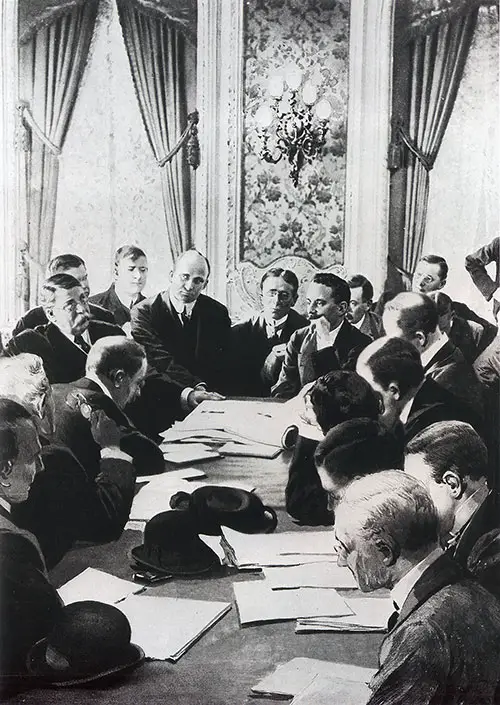
Senator Smith questioned him: Mr. Joseph Bruce Ismay's Evidence at the American Inquiry into the "Titanic" Disaster. The Illustrated London News (18 May 1912) p. 729. GGA Image ID # 1032087e3c
Mr. Joseph Bruce Ismay, a survivor of the "Titanic" disaster, Managing Director of the White Star Line, and President of the International Mercantile Marine Company, was the chief witness at the Senatorial Inquiry. The hearings under Senator Smith of Michigan began in the hall-room of the Waldorf-Astoria Hotel, New York, immediately after the arrival of the Carpathia with survivors, and was transferred to Washington. It was arranged that the first sitting of the British Commission of Inquiry should be held on Thursday, 2 May, at the Scottish Hall, Buckingham Gate. The members of this Commission are Lord Mersey, chairman, appointed a Wreck Commissioner of the United Kingdom on 26 April; and the following assessors — Rear-Admiral the Hon. S. A. Gough-Calthorpe, Captain A. W. Clarke, Commander F. C. Lyon, Professor J. H. Biles, and Mr. E. C Chaston. Captain the Hon. C. Bigham is the secretary. In the photograph, Mr. Ismay is in the center, with his hand to his mouth.
General Particulars of the Steamship "Titanic"
The Titanic was built by Harland & Wolff of Belfast, Ireland. White Star Line did not limit the builders' cost limit.
It was launched on 31 May 1911. She was a vessel of 46,328 tons register; her length was 882.6 feet, and her width was 92.6 feet.
Her boat deck and bridge were 70 feet above the water line. President Ismay testified that she was "specially constructed to float with her two largest watertight compartments full of water."
The vessel, fully equipped, cost £1,500,000 sterling, or about $7,500,000.
At the time of the accident, the vessel carried an insurance policy of £1,000,000 or about $5,000,000, the remaining risk being taken by the company's insurance fund.
The Titanic was a duplicate of the Olympic, owned by the same company, except for her passenger accommodations. It was built to accommodate 2,599 passengers, with additional accommodations for officers and crew numbering 903 persons.
Trial Tests Steamship Titanic
The committee finds from the evidence that between six and seven hours were spout in making trial tests of this vessel at Belfast Lough on Monday, the 1st day of April last. A few turning circles were made, compasses adjusted, and she steamed under approximately a full head of steam for a short time, but Captain Smith of the Titanic did not drive the ship at her full speed.
One general officer of the steamship company was on board during the trial tests, while Mr. Thomas Andrews represented the builders. The latter had superintended the building of the vessel. Mr. Andrews conducted specific tests at Southampton and represented the builders both at Southampton and on the first voyage.
With a partial crew, the ship sailed from Belfast, immediately after the trial, for Southampton, where she arrived on Wednesday, 3 April, at about midnight. She made fast with her port side to the pier, where she remained until 10 April, about noon, when she sailed for Cherbourg, Queenstown, and New York.
Only Two Lifeboats Lowered
Many crew members did not join the ship until a few hours before sailing, and the only drill. At the same time, the vessel lay at Southampton or on the voyage, consisted in lowering two lifeboats on the starboard side into the water, which boats were again hoisted to the boat deck within a half hour.
White Star Line posted no boat list designating the stations of members of the crew until several days after sailing from Southampton, boatmen being left in ignorance of their proper stations until the following Friday morning.
Certificate of British Board of Trade
On Wednesday morning, the day the ship sailed from Southampton, Capt. Clark, a representative of the British Board of Trade, came aboard and, after spending a brief time, issued the necessary certificate to permit sailing.
Boat Davits and Lifeboats on the Steamship "Titanic"
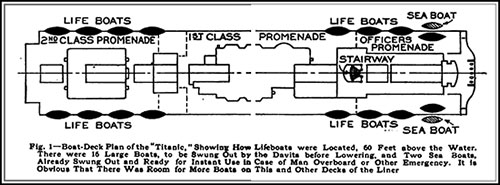
Boat-Deck Plan of the "Titanic," Showing How Lifeboats Were Located, 60 Feet above the Water. There Were 16 Large Boats, to Be 8wung out by the Davits before Lowering, and Two Sea Boats, Already Swung out and Ready for Instant Use in Case of Man Overboard or Other Emergency. There Was Room for More Boats on This and Other Decks of the Liner. Popular Mechanics Magazine (June 1912) p. 806-a & 807-a. GGA Image ID # 1082947e52
The Titanic was fitted with 16 sets of double-acting boat davits of modern type, capable of handling 2 or 3 boats per set of davits. The davits were thus capable of handling 48 lifeboats, whereas the ship carried but 16 lifeboats; and four collapsible, fulfilling all the British Board of Trade requirements.
The Titanic was provided with 14 lifeboats, with a capacity for 65 persons each, or 910 persons; 2 emergency sea boats, with a capacity for 35 persons each, or 70 persons; 4 collapsible boats, of capacity for 49 persons each, or 196 persons. Total lifeboat capacity: 1,176. There was ample life-belt equipment for all.
The Departure of the Steamship "Titanic"
The ship left Southampton Wednesday, 10 April, at 12.15 p. m., with the ship's complement of officers and crew numbering 899 persons.
As the Titanic left the harbor at Southampton, the moorings of the New York were carried away by the backwash from the Titanic's starboard propeller, causing a delay of about half an hour.
The Titanic arrived at Cherbourg late the same afternoon. The Titanic left Cherbourg and proceeded to Queenstown, Ireland, arriving on Thursday about midday, departing for New York immediately after embarking on the mails and passengers.
Summary of Passengers and Survivors
Including the crew, the Titanic sailed with 2,223 persons aboard, of whom 1,517 were lost, and 706 were saved. One will note in this connection that 60 percent of the first-class passengers were rescued, 42 percent of the second-class passengers were saved, 25 percent of the third-class passengers were saved, and 24 percent of the crew were saved.
A complete and exhaustive list of passengers and crew is presented under a different section.
Weather Conditions during the Voyage
During the entire voyage, the weather was clear, except for 10 minutes of fog, and the sea was calm throughout the journey, with sunshine the whole of each day and bright starlight every night. No untoward incident marred the trip. The Titanic frequently exchanged greetings with passing vessels by appropriate signals.
Ice Warnings
On the third day out, ice warnings were received by the wireless operators on the Titanic, and the testimony is conclusive that at least three of these warnings came directly to the commander of the Titanic on the day of the accident, the first about noon, from the Baltic, of the White Star Line.
One will note that this message places icebergs within 5 miles of the track that the Titanic was following and near where the accident occurred.
The Titanic received the second message from the Californian, of the Leyland Line, at 5.35 p. m. New York time, Sunday afternoon, reporting ice about 19 miles to the northward of the track which the Titanic was following.
The third message was transmitted from the Amerika via the Titanic and Cape Race to the Hydrographic Office in Washington, DC, reporting ice about 19 miles to the southward of the course being followed By the Titanic.
The fourth message was sent to the Titanic at 9.05 p. m. New York time, on Sunday, 14 April, approximately an hour before the accident occurred.
The message reads as follows: We are stopped and surrounded by ice.
To this, the operator of the Titanic replied: Shut up. I am busy. I am working at Cape Race.
While this was the last message sent by the Californian to the Titanic, the evidence shows that the operator of the Californian kept the telephone on his head and heard the Titanic talking to Cape Race up to within a few minutes of the time of the accident, when he "put the phones down, took off his clothes, and turned in."
ON THAT SUNDAY, the SS Baltic's operator overheard ice reports going to the Titanic from the SS Prinz Friedrich Wilhelm and the SS Amerika. In contrast, the SS Carpathia overheard the Parisian talking about ice with other ships on the same day.
Ice Both to Northward and Southward Steamship "Titanic" Track
This enables the committee to say that the ice positions so definitely reported to the Titanic just preceding the accident located ice on both sides of the track or lane the Titanic was following and in her immediate vicinity.
No general discussion occurred among the officers; Titanic officers called no conference to consider these warnings; Titanic officers did not heed them. Captain Smith did not relax the speed, the lookout was not increased, and the only vigilance displayed by the officer of the watch was by instructions to the lookouts to keep "a sharp lookout for ice."
It should be said, however, that the testimony shows that Capt. Smith remarked to Officer Lightoller, who was the officer doing duty on the bridge until 10 o'clock ship's time, or 8.27 o'clock New York time, "If it was in a slight degree hazy there would be no doubt we should have to go very slowly" and "If in the slightest degree doubtful, let me know."
The evidence is that it was apparent. There was no haze, and Captain Smith did not reduce the ship's speed.
Speed
The speed of the Titanic gradually increased after leaving Queenstown. The first day's run was 464 miles, the second was 519 miles, and the third was 546 miles. Just before the collision, the ship was making her maximum speed of the voyage—not less than 21 knots, or 24 ¼ miles per hour.
The Collision
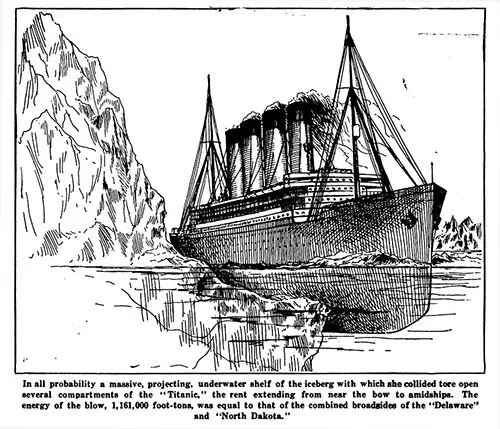
Illustration of the Damage Done to the Titanic Caused by an Iceberg. In all probability, a massive, projecting, underwater shelf of the iceberg with which she collided tore open several compartments of the Titanic, the rent extending from near the bow to amidships. The energy of the blow, 1,161,000 foot tons, was equal to that of the combined broadsides of the USS Delaware and USS North Dakota. Scientific American (27 April 1912) p. 381b. GGA Image ID # 10a4a3ccf2
On Sunday evening, 14 April, New York time, the lookout signaled the bridge and telephoned the officer of the watch, "Iceberg right ahead." At 11.46 p. m. ship's time, or 10.13 p. m.
The watch officer, Mr. Murdoch, immediately ordered the quartermaster at the wheel to put the helm "hard astarboard" and reversed the engines. Still, while the sixth officer standing behind the quartermaster at the wheel reported to officer Murdoch "The helm is hard astarboard," the Titanic struck the ice.
The impact, while not violent enough to disturb the passengers or crew or arrest the ship's progress rolled the vessel slightly and tore the steel plating above the turn of the bilge.
First Damage Reported
The testimony shows that coinciding with the collision. There was heard whistling or hissing from the overflow pipe to the forepeak tank, indicating the air escaped from that tank because of the inrush of water.
Practically at once, the forepeak tank, No. 1 hold, No. 2 hold, No. 3 hold, and the forward boiler room filled with water, the presence of which was reported immediately from the mail room and the racquet court and trunk room in No. 3 hold, and also from the firemen's quarters in No. 1 hold.
Leading Fireman Barret saw the water rushing into the forward fireroom from a tear about two feet above the stokehold floor plates and about twenty feet below the water line. A tear extended two feet into the coal bunker at the forward end of the second fireroom.
Serious Nature of Damage Realized
The reports received by the captain after various inspections of the ship must have acquainted him promptly with its severe condition. When interrogated by President Ismay, he so expressed himself.
It is also believed that this severe condition was promptly realized by the chief engineer and by the builders' representative, Mr. Andrews, none of whom survived.
Flooding of the Vessel
Under this added water weight, the ship's bow sank deeper and deeper into the water. Through the open hatch leading from the mail room and other openings, water promptly overflowed E deck, below which deck the third, fourth, fifth, sixth, seventh, and eighth transverse bulkheads ended and thus flooded the compartments abaft No. 3 hold.
Watertight Compartments
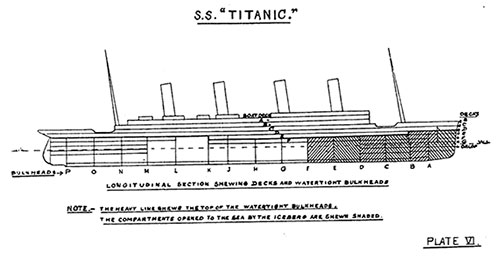
SS Titanic - Longitudinal Section Showing Decks and Watertight Bulkheads. How to Save a Big Ship from Sinking (1915) p. 121. GGA Image ID # 10a2deecbc
The Titanic was fitted with 15 transverse watertight bulkheads. Only 1, the first bulkhead from forward, extended to the uppermost continuous deck, C; bulkheads Nos. 2, 10, 11, 12, 13, 14, and 15 extended to the second continuous deck, D; and bulkheads Nos. 3, 4, 5, 6, 7, 8, and 9 extended only to the third continuous deck, E.
The openings through deck E were not designed for watertight closing, as the evidence shows that flooding over deck E contributed largely to the vessel's sinking.
The bulkheads described above divided the ship into 16 main watertight compartments. The boat was designed so that any two main compartments might be flooded without involving the ship's safety.
The testimony shows that the five extreme-forward compartments were flooded immediately. Under such circumstances, because of the non-water-tight character of the deck at which the transverse bulkheads ended, the supposedly watertight compartments were NOT watertight, and the vessel's sinking followed.
Distress Calls Sent Out
Titanic officers sounded no general alarm, blew no whistle, and gave no systematic warning to the passengers. Within 15 or 20 minutes, the captain visited the wireless room and instructed the operator to get assistance, sending out the distress call, C. Q. D.
Distress calls heard
This distress call was heard by the wireless station at Cape Race that evening at 10.25 p. m. New York time, together with the report that she had struck an iceberg, and at the same time was accidentally overheard by the Mount Temple, which ship was immediately turned around toward the Titanic.
Within two or three minutes, the Titanic received a reply from the SS Frankfurt. Fortunately, within 10 minutes, the wireless operator of the SS Carpathia, and mainly by chance, heard the RMS Titanic's C. Q. D. call, which he reported to the bridge and the captain.
The SS Carpathia immediately turned around and reported her latitude and longitude to the Titanic, together with the fact that she was steaming full speed toward the stricken ship.
HOWEVER, the SS Frankfurt did not give her latitude or longitude, and after waiting 20 minutes, asked the operator of the Titanic, "What is the matter?" To this, the Titanic operator replied that he was a fool.
Since the SS Frankfurt had given no position and her exact distance from the Titanic was unknown at that time, the answer of the operator of the Titanic was scarcely such as prudence would have dictated.
Notwithstanding this, the SS Frankfurt was overheard by the SS Mount Temple to report, "Our captain will go for you."
The Titanic promptly established communication with the SS Olympic and the SS Baltic, and the SS Caronia, some 800 miles eastward, overheard the Titanic's C. Q. D. call.
The wireless messages of the Titanic were recorded in part by the Cape Race station and by the SS Mount Temple, and in part by the SS Baltic.
The SS Mount Temple last heard the Titanic after the accident at 11.47 p. m. New York time. The SS Baltic and the SS Carpathia lost touch about the same time, the last message they received being "Engine room getting flooded." The SS Virginian last heard the RMS Titanic's signals at 12.27 New York time and reported them blurred and ending abruptly.
First Press Report
The information is contained in a report received by the Associated Press from Cape Race and communicated to the public, Vice President Franklin of the White Star Line, and later verified from his office in Montreal.
Vessels in Vicinity of Steamship "Titanic"
At this time, the committee thinks it advisable to invite attention to the reported positions of the vessels in the vicinity of the Titanic when her distress calls were being sent out.
The SS Californian of the Leyland Line, westbound, was in latitude 42° 05' north, longitude 50° 07' west, and was distant in a northerly direction 19 ½ miles, according to the captain's figures.
The SS Mount Temple of the Canadian Pacific Railroad line, westbound, was in latitude 41° 25' north, longitude 51° 14' west, and was about 49 miles to the westward of the Titanic and on her return to the Titanic's position passed an unknown schooner.
The SS Carpathia of the Cunard Line, eastbound, was 58 miles away, and she steered a course north 52° west to reach the Titanic.
The SS Birma, a Russian ship, was 70 miles off at 12.25 a. m. on Monday, 15 April.
The Eastbound SS Frankfurt of the North German Lloyd Line was in latitude 39° 47' north, longitude 52° 10' west, 153 miles to the southwest.
The SS Virginian at midnight was about 170 miles distant from the Titanic.
Eastbound SS Baltic of the White Star Line was about 243 miles southeast of the Titanic's position at about 11 p.m. Sunday, New York time.
The Olympic, of the White Star Line, eastbound, at 12.14, New York time, was about 512 miles to the westward, in latitude 40° 22' north, longitude 61° 18' west.
Steamship Light Seen from Steamship "Titanic"
Sixteen witnesses from the Titanic, including officers and experienced seamen, and passengers of sound judgment, testified to seeing the light of a ship in the distance, and some of the lifeboats were directed to pull for that light, to leave the passengers, and to return to the side of the Titanic.
The Titanic fired distress rockets and attempted to signal by electric lamp and Morse code to this vessel. At about the same time, the officers of the Californian admit to seeing rockets in the general direction of the Titanic and say that they immediately displayed a powerful Morse lamp, which could be easily seen at a distance of 10 miles. At the same time, several of the crew of the SS Californian testify that the side lights of a large vessel going at full speed were visible from the lower deck of the Californian at 1 1 .30 p. m., ship's time, just before the accident.
There is no evidence that any rockets were fired by any vessel between the RMS Titanic and the SS Californian. However, every eye on the Titanic searched the horizon for possible assistance.
The Steamship "Californian's" Responsibility
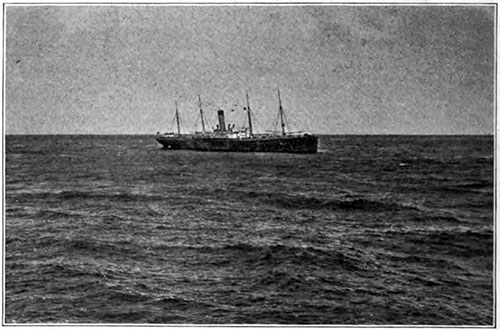
The Leyland Line SS Californian of 6,223 Gross Tons Appearing on the Scene. Scribner's Magazine (March 1913) p. 362. GGA Image ID # 1031be7ef6
The committee is forced to the inevitable conclusion that the SS Californian, controlled by the same company, was nearer the RMS Titanic than the 19 miles reported by her captain and that her officers and crew saw the distress signals of the Titanic and failed to respond to them following the dictates of humanity, international usage, and the requirements of law.
The only reply to the distress signals was a counter signal from a large white light flashed for nearly two hours from the mast of the SS Californian. In our opinion, such conduct, whether from indifference or gross carelessness, is most reprehensible and places upon the commander of the SS Californian a grave responsibility.
The wireless operator of the SS Californian was not aroused until 3.30 a. m., New York time, on the morning of the 15th, after a considerable conversation between officers and members of the crew had taken place aboard that ship regarding these distress signals or rockets, and was directed by the chief officer to see if there was anything the matter, as a ship had been firing rockets during the night.
The inquiry thus set on foot and immediately disclosed that the Titanic had sunk. Had assistance been promptly proffered or had the wireless operator of the SS Californian remained a few minutes longer at his post on Sunday evening, that ship might have had the proud distinction of rescuing the lives of the passengers and crew of the Titanic.
International Signals of Distress at Sea
The committee deems it essential to emphasize the meaning of signals of distress and includes in its report the international code, which is as follows:
Signals of Distress - When a vessel is in distress and requires assistance from other boats or the shore, the following shall be the signals to be used or displayed by her, either together or separately:
In the daytime:
- A gun or other explosive signal is fired at intervals of about a minute.
- NC indicates the international code signal of distress.
- The distant signal consists of a square flag, either above or below a ball or resembling a ball.* (*This is purely a code signal and is not one of the signals of distress given in the Rules of the Road, the needless exhibition of which entails penalties upon the master of the vessel displaying it.)
- The distant signal, consisting of a cone, points upward, having either above it or below it a ball or anything resembling a ball.
- A continuous sounding with any fog-signal apparatus.
At night:
- A gun or other explosive signal is fired at intervals of about a minute.
- Flames on the vessel (as from a burning tar barrel, oil barrel, etc.).
- Rockets or shells, throwing stars of any color or description, fired one at a time at short intervals.
- A continuous sounding with any fog-signal apparatus.
Steamship "Titanic" Lifeboats Cleared Away
When Captain Smith received the reports on the water entering the ship, he promptly gave the order to clear away the lifeboats, and later, Captain Smith gave orders to put women and children into the boats. During this time of distress, rockets were fired at frequent intervals.
The lack of preparation was, at this time, most noticeable. The Titanic had adopted no system for loading the boats; there was great indecision as to the deck from which ships were to be loaded; there was a wide diversity of opinion as to the number of the crew necessary to man each boat; there was no direction whatever as to the number of passengers to be carried by each ship, and no uniformity in loading them.
On one side, Titanic officers put only women and children in the boats. In contrast, on the other side, the Titanic officers put almost an equal proportion of men and women into the lifeboats, the women and children being given the preference in all cases.
The failure to utilize all lifeboats to their recognized capacity for safety unquestionably resulted in the needless sacrifice of several hundred lives that might otherwise have been saved.
The Capacity of Lifeboats Not Utilized
The vessel was provided with lifeboats, as above stated, for 1,176 persons, while 706 were saved. Only a few of the ship's lifeboats were fully loaded, while others were but partially filled. Some were loaded at the boat deck, and some at the A deck, and these were successfully lowered to the water.
The twentieth boat was washed overboard when the forward part of the ship was submerged and, in its overturned condition, served as a life raft for about 30 people, including Second Officer Lightoller, Wireless Operators Bride, and Phillips (the latter dying before rescue), passengers Col. Gracie and Mr. Jack Thayer, and others of the crew, who climbed upon it from the water at about the time the ship disappeared.
Lifeboat devices
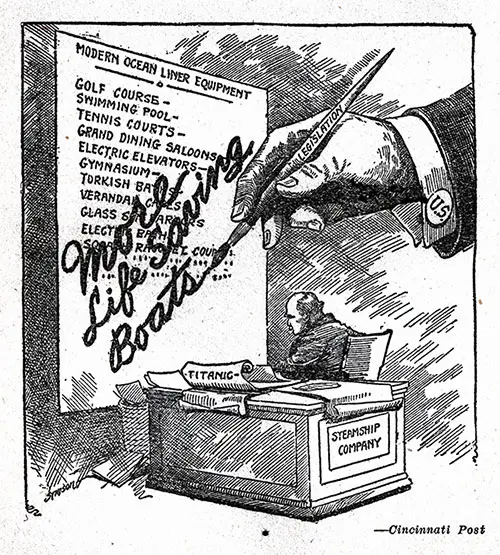
More Life-Saving Boats. © Cincinnati Post. Wreck and Sinking of the Titanic (1912) p. 184. GGA Image ID # 108ea3c86e
Had the sea been rough, it is questionable whether any of the lifeboats of the Titanic would have reached the water without being damaged or destroyed. The point of suspension of the Titanic's boats was about 70 feet above sea level.
Had the ship been rolling heavily, the lifeboats as they were lowered would have swung out from the side of the boat as it moved toward them, and on the return, the roll would have swung back and crashed against its side.
It is evident from the testimony that as the list of the Titanic became noticeable, the lifeboats scraped against the high side as they were being lowered. Every effort should be made to improve boat handling devices and to improve the control of boats while being lowered.
Conflict in Lifeboats Reports
In the reports of the survivors, there are marked differences of opinion as to the number carried by each lifeboat. In lifeboat No. 1, for instance, one survivor reports 10 in all. The seaman in charge notes 7 of the crew and 14 to 20 passengers. The officer who loaded this boat estimated that 3 to 5 women and 22 men were aboard.
Accepting the minimum report made by any survivor in every boat, the total far exceeds the number picked up by the Carpathia.
No Distinction between Passengers
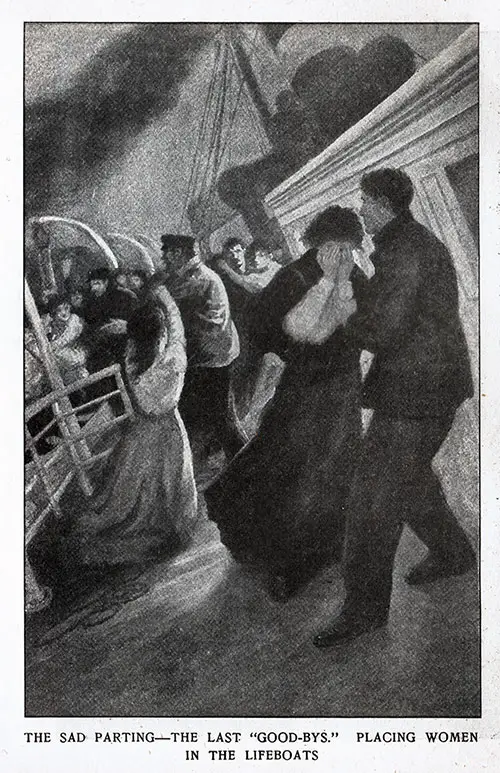
The Last Goodbyes - Placing Women in the Lifeboats. Wreck and Sinking of the Titanic (1912) p. 177. GGA Image ID # 108e86a1fa
The testimony is definite that there was no panic except in isolated instances. In loading boats, no distinction was made between first, second, and third-class passengers, although the proportion of lost is more significant among third-class passengers than in either of the other classes. Women and children, without discrimination, were given preference.
Your committee believes that the survivors could have been concentrated into fewer boats after reaching the water under proper discipline. We think it would have been possible to have saved many lives had those in charge of lifeboats thus released returned promptly to the disaster scene.
Conduct on lifeboats
After lowering, several of the boats rowed many hours in the direction of the lights supposed to have been displayed by the Californian. Other boats lay on their oars in the vicinity of the sinking ship, a few survivors rescued from the water.
After distributing his passengers among the four other boats which he had herded together, and after the cries of distress had died away, Fifth Officer Lowe, in boat No. 14, went to the scene of the wreck and rescued four living passengers from the water, one of whom afterward died in the lifeboat, but was identified.
Officer Lowe then set sail in boat No. 14, took in tow one collapsible boat, and proceeded to the rescue of passengers on another collapsible lifeboat.
The men who had taken refuge on the overturned collapsible lifeboat were rescued, including Second Officer Lightoller and passengers Gracie and Thayer, and Wireless Operators Bride and Phillips, by lifeboats No. 4 and No. 12, before the arrival of the Carpathia.
The fourth collapsible lifeboat was rowed to the side of the SS Carpathia and contained 28 women and children, primarily third-class passengers, three firemen, one steward, 4 Filipinos, President Ismay, and Mr. Carter of Philadelphia, and was in charge of Quartermaster Rowe.
Ship sinking
The ship went down gradually by the bow, assuming an almost perpendicular position just before sinking at 12.47 a. m., New York time, 15 April. There have been many conflicting statements about whether the ship broke in two, but the preponderance of the evidence is that she assumed an almost end-on position and sank intact.
No Suction
The committee deems it of sufficient importance to call attention to the fact that as the ship disappeared under the water, there was no apparent suction or unusual disturbance of the water's surface.
Testimony is abundant that while she was going down, there was not sufficient suction to be manifest to any of the witnesses who were in the water or on the overturned collapsible boat or the floating debris or to the occupants of the lifeboats in the vicinity of the vessel or to prevent those in the water, whether equipped with life belts or not, from quickly swimming away from the snip's side while she was sinking.
Captain Rostron
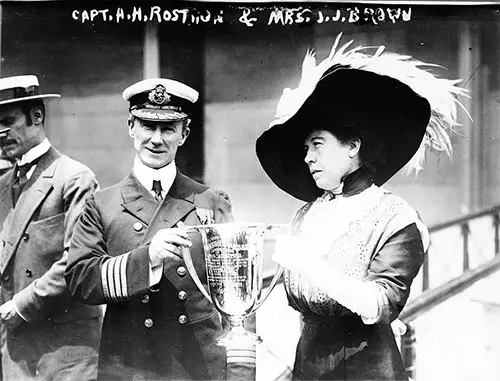
Mrs. J.J. Brown Presenting Trophy Cup Award to Capt. Arthur Henry Roston, for His Service in the Rescue of the Titanic. Library of Congress, Prints and Photographs Division (LC-USZ62-121013). GGA Image ID # 100c6a1f54
The committee deems the course followed by Captain Rostron of the Carpathia as deserving of the highest praise and worthy of special recognition.
Captain Rostron fully realized all the risks involved. He doubled his lookouts and fireroom force and, notwithstanding such risk, pushed his ship at her very highest speed limit through the many dangers of the night to the relief of the stricken vessel.
His detailed instructions in anticipation of the rescue of the Titanic are a marvel of systematic preparation and completeness, evincing such solicitude as calls for the highest commendation.
The precautions he adopted enabled him to steer his course between and around icebergs until he stopped his engines at 4 a.m. in the vicinity of the accident, where he proceeded to pick up the Titanic's lifeboats with the survivors.
On the scene of the wreck
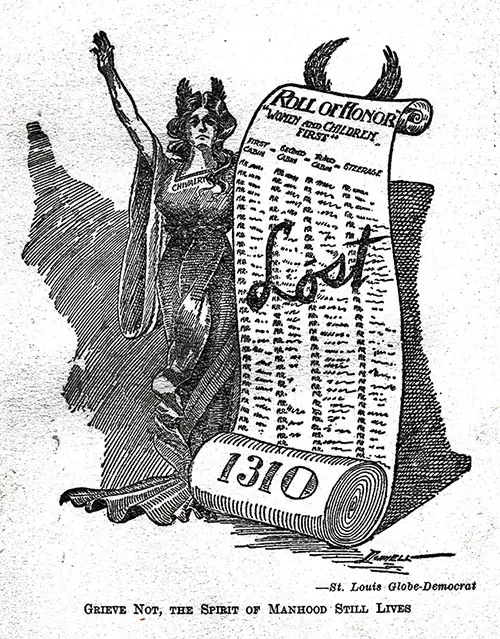
Grieve Not - the Spirit of Manhood Still Lives. © St. Louis Globe-Democrat. Wreck and Sinking of the Titanic (1912) p. 192. GGA Image ID # 108edcce25
The SS Carpathia picked up the first boat at 4.10 a. m. Monday and the last of the survivors were on board by 8.30 a. m., after which Captain Rostron made arrangements "to hold service, a short prayer of thankfulness for those rescued, and a short burial service for those who were lost."
Upon the arrival of the SS Californian upon the scene, about 8 a.m., the captain of the SS Carpathia communicated with her commander, stating that all of the passengers had been rescued from the boats but that he thought one was still unaccounted for. Arrangements were made whereby the Californian did an exhaustive search in the vicinity for this missing boat.
Captain Rostron stated that the Carpathia picked up 15 lifeboats and two collapsible boats. Thirteen of these lifeboats were hoisted on board and carried to New York by the Carpathia. Evidence was given before the committee by at least one occupant of every lifeboat, satisfying the committee that the 16 lifeboats with which the Titanic was equipped were all accounted for.
After arranging for a thorough search of the vicinity by the Californian, Captain Rostron headed his vessel for New York, reporting immediately by wireless to the officials of his company in New York.
Bodies not visible
The committee directs attention to the fact that Captain Rostron of the Carpathia. However, four hours in the vicinity of the accident saw only one body, and Captain Lord of the SS Californian, who remained three hours in the wreckage area, saw none.
The failure of the captain of the Carpathia, of the captain of the Californian, and the captain of the Mount Temple to find bodies floating in that vicinity in the early morning of the day following can only be accounted for on the theory that those who went down with the ship either did not rise to the surface or were carried away or hidden by the extensive ice floe which during the night came down over the spot where the ship disappeared, while those bodies which have been found remote from the place where the boat went down were probably carried away from the scene by the currents or by the movement of the ice.
Wireless Service
Numerous wireless messages of an official character were given to the operator on the Carpathia on Monday morning, 15 April, with explicit instructions from the captain to send them immediately and, if necessary, relay them through other vessels.
Public Information
The record further discloses the first official information concerning the disaster communicated to the public by the officials of the White Star Line was received from Capt. Haddock, of the Olympic, at 6.16 p. m. Monday, 15 April, as follows:
Carpathia reached the Titanic's position at daybreak. Found boats and wreckage only. All her boats were accounted for. Titanic had foundered about 2.20 a. m. in 41.16 north, 50.14 west.
The Leyland Line steamship Californian remained in and searched the position of disaster. About 675 souls were saved, crew and passengers, nearly all women and children. Carpathia is returning to New York with survivors; please inform Cunard. Signed, Haddock.
Notwithstanding this information in possession of the officials of that company, a telegram was sent to Representative J. A. Hughes, Huntington, W. Va., dated New York, 15 April 1912, reading as follows:
Titanic proceeding to Halifax. Passengers will probably land there Wednesday, all safe. Signed, White Star Line
The committee has been unable to fix the identity of the author of this telegram. We find, however, that this message was delivered to the Western Union branch office, in the same building as the offices of the White Star Line, 11 Broadway, at 7.51 p. m., on that day, but are left wholly in doubt as to the person who sent it or the purpose of the author in sending such a message. Whoever sent this message, under the circumstances, is guilty of the most reprehensible conduct.
Information Withheld
The committee does not believe that the wireless operator on the Carpathia showed proper vigilance in handling the vital work confided to his care after the accident.
A wireless operator had used information concerning an accident at sea before this accident for his advantage. That the Marconi Co. had permitted such procedure may have affected this occasion.
The disposition of officials of the Marconi Co. to permit this practice and the fact that the company's representatives make arrangements for the sale of the experiences of the operators of the Titanic and Carpathia subject the participants to criticism, and the practice should be prohibited. The committee is pleased to note that Mr. Marconi approves of such prohibition.
Recommendations
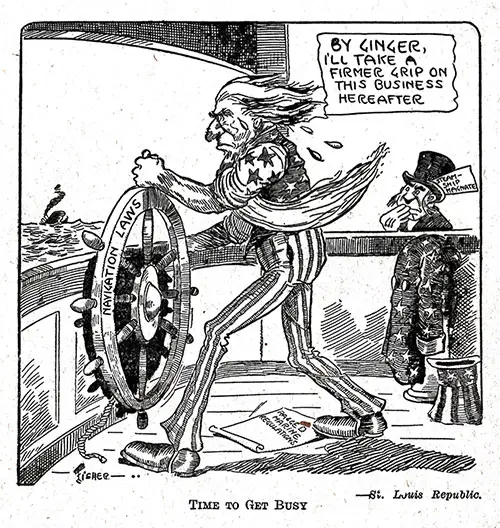
Time to Get Busy. © the St. Louis Republic. Wreck and Sinking of the Titanic (1912) p. 245. GGA Image ID # 10949b5928
The committee finds that this accident indicates the necessity of additional legislation to secure the safety of life at sea.
By statute, the United States accepts reciprocally the inspection certificates of foreign countries having inspection laws approximating those of the United States. Unless there is an early revision of inspection laws of foreign countries along the lines laid down in the future, the committee deems it proper that such reciprocal arrangements be terminated and that no vessel shall be licensed to carry passengers from ports of the United States until all regulations and requirements of the laws of the United States have been fully complied with.
The committee recommends that sections 4481 and 4488, Revised Statutes, be so amended as to require sufficient lifeboats to accommodate every passenger and every member of the crew.
That the steamship lines recognize the importance of this feature is indicated by the fact that on many lines, steps are being taken to provide lifeboat capacity for every person on board, including the crew, and the fact that such equipment is being widely advertised.
The President of the International Mercantile Marine Co., Mr. Ismay, definitely stated to the committee: We have issued instructions that none of the ships of our lines shall leave any port carrying more passengers and crew than they have the capacity for in the lifeboats.
No less than four crew members skilled in handling boats should be assigned to every ship. All crew members assigned to lifeboats should be drilled in lowering and rowing the boats, not less than twice each month, and the ship's officers should note the fact of such drill or practice in the log.
The committee recommends the assignment of passengers and crew to lifeboats before sailing; that occupants of certain groups of staterooms and the stewards of such groups of rooms be assigned to certain boats most conveniently located concerning the rooms in question; the assignment of ships and the shortest route from stateroom to boat to be posted in every stateroom.
The committee recommends that every ocean steamship carrying 100 or more passengers have two electric searchlights.
The committee finds that this catastrophe makes daringly apparent the necessity for regulation of radiotelegraphy. There must be an operator on duty at all times, day and night, to ensure the immediate receipt of all distress, warning, or other important calls.
Direct communication either by clear-speaking telephone, voice tube, or messenger must be provided between the wireless room and the bridge so that the operator does not have to leave his station.
There must be definite legislation to prevent amateur interference and secure the secrecy of radiograms or wireless messages. There must be some source of auxiliary power, either a storage battery or oil engine, to ensure the operation of the wireless installation until the wireless room is submerged.
The committee recommends the early passage of S. 6412, already passed by the Senate and favorably reported by the House.
The committee recommends that the firing of rockets or candles on the high seas for any other purpose than as a signal of distress be made a misdemeanor.
The committee recommends that the following additional structural requirements be required as regards ocean-going passenger steamers, the construction of which is begun after this date:
All steel ocean and coastwise seagoing ships carrying 100 or more passengers should have a watertight skin inboard of the outside plating, extending not less than 10 percent of the load draft above the full-load waterline in the form of an inner bottom or longitudinal watertight bulkheads. This construction should extend from the forward collision bulkhead over not less than two-thirds of the ship's length.
All steel ocean and coastwise seagoing ships carrying 100 or more passengers should have bulkheads so spaced that any two adjacent compartments of the vessel may be flooded without destroying the seaworthiness or stability of the ship.
Watertight transverse bulkheads should extend from side to side of the ship, attaching to the outside shell. The transverse bulkheads forward and abaft the machinery spaces should remain watertight vertically to the uppermost continuous structural deck.
The uppermost continuous structural deck should be fitted watertight. Bulkheads within the machinery spaces' limits should extend less than 25 percent of the ship's draft above the load waterline and end at a watertight deck.
All watertight bulkheads and decks should be proportioned to withstand, without permanent material deflection, a water pressure equal to 5 feet more than the full height of the bulkhead.
Bulkheads of novel dimensions or scantlings should be tested by being subjected to actual water pressure.
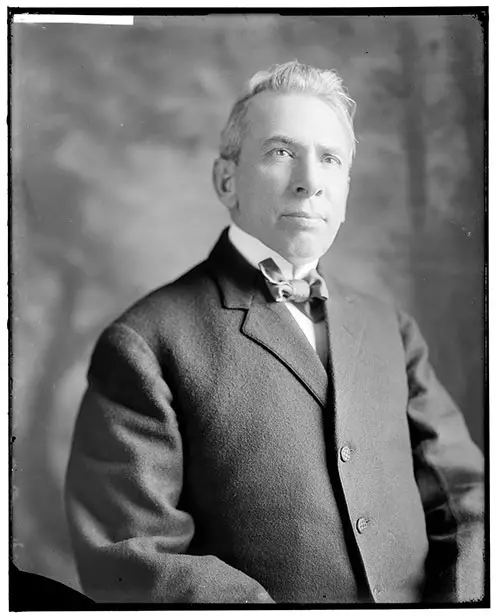
Senator William Alden Smith conducted the Senatorial Inquiry into the "Titanic" Disaster in New York and Washington. Library of Congress (LC-DIG-hec-15852). GGA Image ID # 103254c02e
The Titanic Disaster Hearings
The Titanic hearings were conducted by a special subcommittee of the Senate Commerce Committee and chaired by Senator William A. Smith (R-MI).
The hearings began on 19 April 1912 at the Waldorf-Astoria Hotel in New York City. The following week the hearings were moved to the new caucus room of the Russell Senate Office Building in Washington, DC.
They were the first hearings to be held in that room. A total of 82 witnesses testified about ignored ice warnings, the inadequate number of lifeboats, the ship's speed, the failure of nearby vessels to respond to the Titanic's distress calls, and the treatment of passengers of different classes.
The hearings concluded on 28 May 1912, when Senator Smith visited the Titanic's sister ship, Olympic, at a port in New York to interview some of its crew. When the Titanic sank, the SS Olympic was about 500 miles away.
The subcommittee hearing transcripts, published in 1912, are over 1,100 pages long. They were issued as Senate Document 726, 62nd Congress, 2nd Session, and are called: "Titanic" Disaster: Hearings before a Subcommittee of the Committee on Commerce, United States Senate, Sixty-Second Congress, Second Session, according to S. Res. 283, Directing the Committee on Commerce to Investigate the Causes Leading to the Wreck of the White Star Liner "Titanic."
Spawned by the popularity of the movie Titanic, a paperback reprint of the hearings was published in 1998 by Pocket Books, called The Titanic Disaster Hearings: The Official Transcripts of the 1912 Senate Investigation. This paperback is an exact reprint of the hearing transcripts. There is an index to the testimony broken out by topic–such as "collision, the effect of" and "ship light in the distance."
Other congressional documents issued in 1912 as a result of the Titanic investigation include:
The final report issued by the committee contains the panel's conclusions about the causes of the disaster. The report was published as Senate Report 806, 62nd Congress, 2nd Session, and is called: "Titanic" Disaster: Report of the Committee on Commerce, United States Senate, according to S. Res. 283, Directing the Committee on Commerce to Investigate the Causes Leading to the Wreck of the White Star Liner "Titanic," Together with Speeches Thereon by Senator William Alden Smith of Michigan and Senator Isidor Rayner of Maryland.
The investigative report issued by the British Government, which was reprinted as Senate Document 933, 62nd Congress, 2nd Session, and called Loss of the Steamship "Titanic": Report of a Formal Investigation into the Circumstances Attending the Foundering on 15 April 1912, of the British Steamship "Titanic," of Liverpool, after Striking Ice in or near Latitude 41º 46' N., Longitude 50º 14' W., North Atlantic Ocean, as Conducted by the British Government.
A law (37 Stat. 639) to award medals of honor to the captain, officers, and crew of the ship Carpathia, which picked up the survivors of the Titanic.
A law (37 Stat. 644) to establish a memorial to Archibald W. Butt and Francis D. Millet, commissioned officers who went down with the sinking of the Titanic.
Bibliography
Excerpts from "Investigation Into Loss of SS Titanic -- American Inquiry," in Report No, 806 62d Congress, 2d Session, by Mr. Smith of Michigan, from the Committee on Commerce, 28 May 1912 [According to S. Res. 283].
"Titanic Disaster Hearings: The Official Transcripts of the 1912 Senate Investigation" United States Senate Reference on the Titanic Hearings and Aftermath. Retrieved 2 May 2019. URL: https://www.senate.gov/reference/reference_item/titanic.htm
